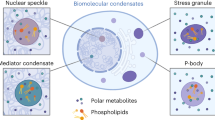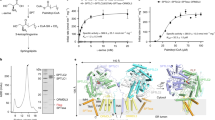Abstract
The Clara cell phospholipid-binding protein, previously referred to as CC10, is a homodimeric protein of Mr 15, 800. It is secreted into the bronchioalveolar lining layer in mammalian lung. A combination of X-ray crystallography and chemical analysis was used to determine that phosphatidylcholine and phophatidylinositol are bound to the protein as isolated from human lung lavage. We now report the crystal structure of the protein–phospholipid complex at 1.9 Å resolution. The phospholipid is bound inside the protein's large hydrophobic cavity. A model is proposed for the manner in which a channel may open to provide access to the cavity, allowing the binding or potential release of phospholipid.
This is a preview of subscription content, access via your institution
Access options
Subscribe to this journal
Receive 12 print issues and online access
$189.00 per year
only $15.75 per issue
Buy this article
- Purchase on Springer Link
- Instant access to full article PDF
Prices may be subject to local taxes which are calculated during checkout
Similar content being viewed by others
References
Rueckert, D.G. & Schmidt, K. Lipid transfer proteins. Chem. Phys. Lipids 56, 1–20 (1990).
Wirtz, K.W.A. Phospholipid transfer proteins: from lipid monolayers to cells. Klin. Wochenschr. 69, 105–111 (1991).
Engle, M.J., Van Golde, L.M.G. & Wirtz, K.W. Transfer of phospholipids between subcellular fractions of the lung. FEBS Lett. 86, 277–281 (1978).
Scarpelli, E.M. Surfactants and the lining of the lung 1–126 (Johns Hopkins University Press, Baltimore, 1988).
Gazdar, A.F. & Linnoila, R.I. The pathology of lung cancer — changing concepts and newer diagnostic techniques. Semin. Oncol. 15, 215–225 (1988).
Evans, M.J., Cabral-Anderson, L.J. & Freeman, G. Role of Clara cell in renewal of the bronchial epithelium. Lab. Invest. 38, 648–655 (1978).
Boyd, M.R. Evidence for the Clara cell as a site of cytochrome P450-dependent mixed-function oxidase activity in lung. Nature 269, 713–715 (1977).
Singh, G. et al. Amino-acid and cDNA nucleotide sequences of human Clara cell 10 kDa protein. Biochim. biophys. Acta 950, 329–337 (1988).
Singh, G. et al. Clara cell 10 kda protein (CC10): comparison of structure and function to uteroglobin. Biochim. biophys. Acta 1039, 348–355 (1990).
Mantile, G., et al. Human Clara cell 10-kDa protein is the counterpart of rabbit uteroglobin. J. biol. Chem. 268, 20343–20351 (1993).
Andersson, O. et al. Purification and level of expression in bronchoalveolar lavage of a human polychlorinated biphenyl (PCB)-binding protein: evidence for a structural and functional kinship to the multihormonally regulated protein uteroglobin. Am. J. Respir. Cell molec. Biol. 5, 6–12 (1991).
Gillner, M. et al. The binding of methylsulfonyl-polychlorobiphenyls to uteroglobin. J. steroid Biochem. 31, 27–33 (1988).
Peter, W. et al. Interchain cysteine bridges control entry of progesterone to the central cavity of the uteroglobin dimer. Prot. Engng. 5, 351–359 (1992).
Peter, W., Brüller, H.-J., Vriend, G., Beato, M. & Suske, G. Identification of residues essential for progesterone binding to uteroglobin by site-directed mutagenesis. J. steroid Biochem. molec. Biol. 38, 27–33 (1991).
Tancredi, T., Temussi, P.A. & Beato, M. Interaction of oxidized and reduced uteroglobin with progesterone. Eur. J. Biochem. 122, 101–104 (1982).
Bourbon, J.R. in Pulmonary surfactant: biochemical, functional, regulatory, and clinical concepts (ed. Bourbon, J. R.) 127–141 (CRC Press, Florida, 1991).
Robinson, D.H., Kirk, K.L. & Benos, D.J. Macromolecular transport in rabbit blastocysts: evidence for a specific uteroglobin transport system. Molec. cell. Endocr. 63, 227–237 (1989).
van Tilbeurgh, H. et al. Interfacial activation of the lipase–procolipase complex by mixed micelles revealed by X-ray crystallography. Nature 362, 814–820 (1993).
Grippo, J.F., Tienrungroj, W., Dahmer, M.K., Housley, P.R. & Pratt, W.B. Evidence that the endogenous heat-stable glucocorticoid receptor-activating factor is thioredoxin. J. biol. Chem. 258, 13658–13664 (1983).
Baker, M.E. Amino acid sequence homology between rat prostatic steroid binding protein and rabbit uteroglobin. Biochem. biophys. Res. Commun. 114, 325–330 (1983).
Morgenstern, J.P., et al. Amino acid sequence of Fel dl, the major allergen of the domestic cat: protein sequence analysis and cDNA cloning. Proc. natn. Acad. Sci. U.S.A. 88, 9690–9694 (1991).
Miele, L., Cordella-Miele, E., Facchiano, A. & Mukherjee, A.B. Novel anti-inflammatory peptides from the region of highest similarity between uteroglobin and lipocortin I. Nature 335, 726–730 (1988).
Huber, R. et al. Crystal and molecular structure of human annexin V after refinement. J. molec. Biol. 223, 683–704 (1992).
Singh, G. et al. Identification, cellular localization, isolation and characterization of human Clara cell 10 KD protein. J. Histochem. Cytochem. 36, 73–80 (1988).
Umland, T.C. et al. The crystallization and preliminary analysis of two crystal forms of human Clara celss 16 kDa protein (cc 10). Acta cryst., Section D, (in the press).
Blum, M., Metcalf, P., Harrison, S.C. & Wiley, D.C. A system for collection and on-line integration of X-ray diffraction data from a multiwire area detector. J. appl. Cryst. 20, 235–242 (1987).
Howard, A.J., Gilliland, G.L., Finzel, B.C. & Poulos, T.L. The use of an imaging proportional counter in macromolecular crystallography. J. appl. Cryst. 20, 383–387 (1987).
Weissman, L. in Computational crystallography (ed. Sayre, D.) 56–63 (Clarendon Press, Oxford, 1982).
Fitzgerald, P.M.D. MERLOT: an integrated package of computer programs for the determination of crystal structures by molecular replacement. J. appl. Cryst. 21, 273–278 (1988).
Umland, T.C. et al. Refined structure of rat Clara cell 17 kDa protein at 3.0 Å resolution. J. molec. Biol. 224, 442–448 (1992).
Furey, W. & Swaminathan, S. PHASES — a program package for the processing and analysis of diffraction data from macromolecules. American crystallographic association meeting, New Orleans, LA, abstract PA33 (1990).
Bruenger, A.T., Kuriyan, J. & Karplus, M. Crystallographic R factor refinement by molecular dynamics. Science 235, 458–460 (1987).
Furey, W., Wang, B.C. & Sax, M. Crystallographic computing on an array processor. J. appl. Cryst.. 15, 160–166 (1982).
Sack, J.S. CHAIN — A crystallographic modeling program. J. molec. Graphics 6, 224–225 (1988).
Folch, P.J., Lees, M. & Sloane-Stanley, G.H. A simple method for the isolation and purification of total lipids from animal tissues. J. biol. Chem. 266, 497–505 (1957).
Skipski, V.P., Peterson, R.F. & Barkley, M. Quantitative analysis of phospholipids by thin-layer chromatography. J. Lipid Res. 90, 374–378 (1964).
Barlett, G.R. 1 Phosphorus assay in column chromatography. J. biol. Chem. 234, 466–468 (1959).
Lepage, G. & Roy, C.C. Direct transesterification of all classes of lipids in a one step reaction. J. Lipid Res. 27, 114–120 (1986).
Carson, M. RIBBONS 2.0. J. appl. Cryst. 24, 958–961 (1991).
Author information
Authors and Affiliations
Rights and permissions
About this article
Cite this article
Umland, T., Swaminathan, S., Singh, G. et al. Structure of a human Clara cell phospholipid-binding protein–ligand complex at 1. 9 Å resolution. Nat Struct Mol Biol 1, 538–545 (1994). https://doi.org/10.1038/nsb0894-538
Received:
Accepted:
Issue Date:
DOI: https://doi.org/10.1038/nsb0894-538
This article is cited by
-
Aryl hydrocarbon receptor promotes lipid droplet biogenesis and metabolic shift in respiratory Club cells
Human Cell (2021)
-
Chronic obstructive pulmonary disease and inflammatory biomarkers in retired workers exposed to inorganic dusts
Toxicology and Environmental Health Sciences (2013)
-
Immunohistochemical analysis of secretoglobin SCGB 2A1 expression in human ocular glands and tissues
Histochemistry and Cell Biology (2006)
-
Application of the disulfide trapping approach to explain the antiparallel assembly of dimeric rabbit uteroglobin: A preliminary study using short peptide models
Letters in Peptide Science (1999)
-
Twixt form and function
Nature Structural & Molecular Biology (1995)



